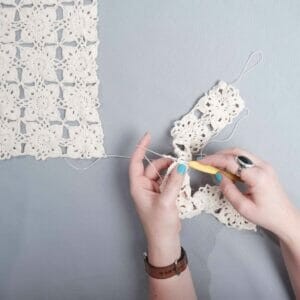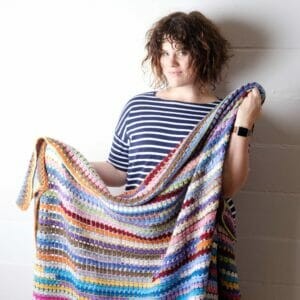Is Learning To Crochet Hard? Yes, learning to crochet presents initial challenges, but it’s a rewarding craft accessible to everyone. LEARNS.EDU.VN offers resources and guidance to navigate the learning curve, turning beginners into confident crocheters. Unlock your creative potential with crochet instruction, yarn selection tips, and essential crochet techniques.
1. Understanding the Initial Challenges of Learning to Crochet
Crocheting, like any new skill, comes with its own set of initial hurdles. Understanding these challenges can help you prepare for the learning process and overcome them more effectively. It is vital to approach crocheting with patience and a willingness to learn, as these challenges are temporary and surmountable.
- Coordination and Dexterity: One of the first challenges is developing the necessary hand-eye coordination and dexterity. Crocheting involves manipulating a hook and yarn to create stitches, which can feel awkward and unnatural at first.
- Understanding Basic Stitches: Learning the basic crochet stitches, such as chain stitch, single crochet, and double crochet, is fundamental. Each stitch has its own technique, and mastering them requires practice and attention to detail.
- Tension Control: Maintaining consistent tension is crucial for creating even and professional-looking crochet projects. Beginners often struggle with tension control, resulting in stitches that are too tight or too loose.
- Reading Patterns: Crochet patterns can seem like a foreign language to beginners. They use abbreviations, symbols, and specific instructions that can be confusing to decipher.
- Yarn and Hook Selection: Choosing the right yarn and hook size can significantly impact the outcome of a crochet project. Beginners may find it challenging to select appropriate materials for their skill level and project goals.
2. Why Learning to Crochet is Worth the Effort
Despite the initial challenges, learning to crochet is a worthwhile endeavor with numerous benefits. Crocheting is not just a hobby; it’s a skill that can bring joy, relaxation, and a sense of accomplishment.
- Creativity and Self-Expression: Crocheting allows you to express your creativity and personal style through a wide range of projects. You can create unique and personalized items, from clothing and accessories to home décor and gifts.
- Stress Relief and Relaxation: The rhythmic and repetitive motions of crocheting can have a calming effect on the mind and body. It can be a great way to relieve stress, reduce anxiety, and promote relaxation. According to a study published in the “British Journal of Occupational Therapy,” engaging in crafts like crocheting can lower heart rate and blood pressure.
- Improved Focus and Concentration: Crocheting requires focus and concentration, which can help improve your attention span and cognitive function. It can also be a form of mindfulness, allowing you to be present in the moment and disconnect from distractions.
- Sense of Accomplishment: Completing a crochet project, no matter how small, provides a sense of accomplishment and pride. It’s rewarding to see your hard work and dedication transform into a tangible and beautiful creation.
- Community and Connection: Crocheting can be a social activity, connecting you with like-minded individuals through online communities, local groups, and workshops. Sharing your passion for crocheting can lead to new friendships and support.
- Sustainable and Eco-Friendly: Crocheting allows you to create reusable and sustainable items, reducing your reliance on mass-produced goods. You can use eco-friendly yarns and materials, contributing to a more sustainable lifestyle.
3. Step-by-Step Guide to Mastering Crochet
Ready to embark on your crochet journey? Here’s a step-by-step guide to help you master the basics and progress to more advanced techniques. Remember, practice makes perfect, so be patient with yourself and enjoy the process.
Step 1: Gather Your Supplies
- Yarn: Choose a light-colored, smooth yarn in a medium weight (DK or worsted) for beginners. Cotton or acrylic yarns are good options as they are easy to work with and show stitch definition clearly.
- Crochet Hook: Select a crochet hook size that corresponds to your yarn weight. The yarn label usually provides a recommended hook size. For DK yarn, a 4mm or 5mm hook is suitable.
- Scissors: A pair of sharp scissors for cutting yarn.
- Yarn Needle: A yarn needle with a large eye for weaving in loose ends.
- Stitch Markers: Stitch markers to mark important stitches or rows.
Step 2: Learn Basic Stitches
- Slip Knot: Create a slip knot to start your crochet project.
- Wrap the yarn around your fingers, forming a loop.
- Insert the hook into the loop and pull the yarn through to create a new loop.
- Tighten the knot on the hook.
- Chain Stitch (ch): The foundation for most crochet projects.
- Yarn over (wrap the yarn around the hook).
- Pull the yarn through the loop on the hook.
- Repeat to create a chain of desired length.
- Single Crochet (sc): A basic stitch that creates a dense fabric.
- Insert the hook into the second chain from the hook.
- Yarn over and pull up a loop (two loops on the hook).
- Yarn over and pull through both loops on the hook.
- Double Crochet (dc): A taller stitch that creates a more open fabric.
- Yarn over.
- Insert the hook into the third chain from the hook.
- Yarn over and pull up a loop (three loops on the hook).
- Yarn over and pull through the first two loops (two loops on the hook).
- Yarn over and pull through the remaining two loops.
Step 3: Practice Tension Control
- Hold the yarn comfortably in your non-dominant hand.
- Maintain a consistent tension by gently guiding the yarn through your fingers.
- Avoid pulling the yarn too tightly or letting it become too loose.
- Practice crocheting rows of single crochet and double crochet, focusing on maintaining even stitches.
Step 4: Read Crochet Patterns
- Familiarize yourself with common crochet abbreviations and symbols.
- Start with simple patterns that use basic stitches.
- Read the pattern carefully before starting, paying attention to stitch counts and instructions.
- Use stitch markers to keep track of rows or important stitches.
Step 5: Practice Regularly
- Set aside time each day or week to practice crocheting.
- Start with small projects, such as scarves, dishcloths, or hats.
- Gradually progress to more complex patterns and techniques as your skills improve.
- Don’t be afraid to make mistakes; they are part of the learning process.
Step 6: Seek Guidance and Inspiration
- Explore online resources, such as tutorials, videos, and forums.
- Join a local crochet group or workshop.
- Follow crochet designers and bloggers for inspiration and tips.
- Visit LEARNS.EDU.VN for comprehensive crochet courses and resources.
4. Common Mistakes Beginners Make and How to Avoid Them
Even with the best guidance, beginners often make common mistakes when learning to crochet. Being aware of these mistakes and knowing how to avoid them can accelerate your learning process.
- Incorrect Hook Size: Using the wrong hook size can result in stitches that are too tight or too loose. Always check the yarn label for the recommended hook size and adjust as needed to achieve the desired gauge.
- Inconsistent Tension: Inconsistent tension leads to uneven fabric and a sloppy appearance. Practice maintaining consistent tension by guiding the yarn gently and avoiding pulling too tightly or letting it become too loose.
- Miscounting Stitches: Miscounting stitches can throw off the entire pattern. Use stitch markers to mark the beginning and end of rows, and count your stitches regularly to ensure accuracy.
- Ignoring Gauge: Gauge is the number of stitches and rows per inch or centimeter. Ignoring gauge can result in projects that are too large or too small. Always make a gauge swatch before starting a project and adjust your hook size if necessary.
- Skipping Stitches: Skipping stitches creates holes in your fabric and affects the overall appearance. Pay close attention to each stitch and ensure you are inserting your hook into the correct place.
- Not Weaving in Ends: Failing to weave in loose ends can cause your project to unravel over time. Use a yarn needle to weave in all loose ends securely, following the direction of the stitches.
- Giving Up Too Soon: Learning to crochet takes time and patience. Don’t get discouraged if you don’t see results immediately. Keep practicing and seek guidance when needed.
5. Choosing the Right Yarn and Hook for Your Project
Selecting the right yarn and hook is essential for successful crochet projects. Different yarns and hooks are suited for different projects and skill levels.
Yarn Types:
| Yarn Type | Description | Best For |
|---|---|---|
| Cotton | Soft, durable, and easy to work with. Good stitch definition. | Dishcloths, baby items, summer garments. |
| Acrylic | Affordable, versatile, and easy to care for. Available in a wide range of colors and textures. | Blankets, scarves, hats, and general-purpose projects. |
| Wool | Warm, durable, and natural. Provides excellent insulation. | Winter garments, blankets, and accessories. |
| Blends | Combine the properties of different fibers. Offer a balance of softness, durability, and affordability. | Versatile and suitable for a wide range of projects. |
| Specialty Yarns | Novelty yarns with unique textures, colors, and effects. | Adding decorative elements to projects. |
| Super Bulky Yarns | Create large, chunky stitches that are easy to see and work with. Great for beginners. Projects work up very quickly. | Perfect for cozy blankets and scarves, especially if you want a project completed in just a few hours. |
| Bamboo Yarn | Lightweight and has a silky texture, making it perfect for summer projects. It is also eco-friendly and has antibacterial | Clothing, delicate shawls, and baby items. |




Hook Types:
| Hook Type | Material | Pros | Cons |
|---|---|---|---|
| Aluminum | Lightweight, smooth, and durable. | Affordable, versatile, and suitable for most yarn types. | Can be cold to the touch and may cause squeaking with certain yarns. |
| Plastic | Lightweight and warm to the touch. | Affordable and comfortable to hold. | Can be less durable than metal hooks and may have rough edges. |
| Bamboo | Lightweight, warm, and natural. | Provides good grip and is comfortable to hold. Eco-friendly. | Can be less durable than metal hooks and may snag on certain yarns. |
| Ergonomic Handles | Designed with cushioned or shaped handles to reduce hand fatigue and strain. | Comfortable to hold and can improve grip. Ideal for those with arthritis or other hand conditions. | Usually more expensive than standard hooks. |
| Steel Hooks | Very small, used for fine yarn. | Perfect for intricate projects using lace or thread. | Can be challenging to use for beginners due to their small size. |
Tips for Choosing Yarn and Hooks:
- Consider the project you want to make and the desired outcome.
- Read the yarn label for recommended hook size and care instructions.
- Choose a yarn and hook that are comfortable to work with.
- Experiment with different yarn and hook combinations to find what works best for you.
6. Essential Crochet Techniques to Master
In addition to basic stitches, there are several essential crochet techniques that can enhance your skills and allow you to tackle more complex projects.
- Increasing: Adding stitches to increase the width or length of your project.
- Work two or more stitches into the same stitch.
- Use increases to shape items such as hats, sleeves, and amigurumi.
- Decreasing: Reducing stitches to decrease the width or length of your project.
- Work two or more stitches together to create a single stitch.
- Use decreases to shape items such as hats, necklines, and amigurumi.
- Changing Colors: Seamlessly changing colors in your crochet project.
- Join the new color in the last stitch of the previous color.
- Carry the unused color along the edge or weave it in as you go.
- Working in Rounds: Crocheting in a continuous spiral to create circular or tubular shapes.
- Use stitch markers to mark the beginning of each round.
- Increase or decrease stitches as needed to maintain the desired shape.
- Joining Pieces: Joining separate crochet pieces together to create larger projects.
- Use a yarn needle to sew the pieces together with a whip stitch or mattress stitch.
- Crochet the pieces together with a slip stitch or single crochet.
- Blocking: Shaping and setting your finished crochet project.
- Wet block by soaking the project in water and pinning it to a blocking board until dry.
- Steam block by hovering a steam iron over the project and gently shaping it.
7. Tips for Improving Your Crochet Speed and Efficiency
As you gain experience, you may want to improve your crochet speed and efficiency. Here are some tips to help you crochet faster and more effectively.
- Optimize Your Posture: Sit comfortably with good posture to reduce strain on your hands, wrists, and back.
- Use an Ergonomic Hook: Ergonomic hooks with cushioned handles can reduce hand fatigue and improve grip.
- Streamline Your Movements: Minimize unnecessary movements and focus on smooth, efficient motions.
- Learn to Crochet Without Looking: With practice, you can learn to crochet without constantly looking at your work, allowing you to focus on other things, such as watching TV or listening to music.
- Practice Speed Drills: Set a timer and practice crocheting a specific stitch or pattern as quickly as possible.
- Take Breaks: Take regular breaks to stretch your hands and wrists and avoid overuse injuries.
- Listen to Audiobooks or Podcasts: Make crocheting more enjoyable by listening to audiobooks or podcasts while you work.
8. Overcoming Challenges and Staying Motivated
Learning to crochet can be challenging at times, and it’s important to have strategies for overcoming obstacles and staying motivated.
- Set Realistic Goals: Break down large projects into smaller, more manageable steps.
- Celebrate Your Progress: Acknowledge and celebrate your achievements, no matter how small.
- Join a Crochet Community: Connect with other crocheters for support, encouragement, and inspiration.
- Try New Techniques: Keep learning and experimenting with new stitches, patterns, and techniques to keep things interesting.
- Take a Class or Workshop: Learn from experienced instructors and gain new skills.
- Reward Yourself: Treat yourself to new yarn, hooks, or other crochet supplies when you reach milestones.
- Remember Why You Started: Reflect on the reasons why you wanted to learn to crochet in the first place and focus on the joy and satisfaction it brings.
9. Advanced Techniques and Projects to Explore
Once you’ve mastered the basics, there’s a whole world of advanced crochet techniques and projects to explore.
- Advanced Stitches: Learn complex stitches such as Tunisian crochet, filet crochet, and tapestry crochet.
- Lace Crochet: Create delicate and intricate lace patterns with fine yarns and small hooks.
- Amigurumi: Crochet three-dimensional figures and characters.
- Garment Design: Design and crochet your own custom clothing.
- Colorwork: Explore advanced colorwork techniques such as intarsia and fair isle.
- Freeform Crochet: Create unique and abstract designs without following a pattern.
- Mixed Media: Incorporate other materials, such as beads, buttons, and fabric, into your crochet projects.
- Irish Crochet: Create beautiful floral motifs that connect with a mesh of chain stitches.
10. Resources and Tools for Continued Learning
To continue your crochet journey, take advantage of the many resources and tools available online and in your community.
- Online Tutorials and Videos: YouTube, Vimeo, and other video platforms offer a wealth of free crochet tutorials.
- Crochet Blogs and Websites: Many crochet bloggers and websites provide patterns, tips, and inspiration.
- Online Forums and Communities: Join online crochet forums and communities to connect with other crocheters.
- Crochet Books and Magazines: Libraries and bookstores offer a wide selection of crochet books and magazines.
- Local Yarn Stores: Local yarn stores often offer classes, workshops, and expert advice.
- Crochet Apps: There are many crochet apps available for smartphones and tablets that provide patterns, stitch counters, and other useful tools.
- LEARNS.EDU.VN: Explore comprehensive crochet courses and resources at LEARNS.EDU.VN.
11. Understanding Yarn Dye Lots
Yarn dye lots refer to a number assigned to yarn that was dyed in the same batch. This number is essential because slight color variations can occur between different dye lots, even if they are the same color number.
Why Dye Lots Matter:
- Color Consistency: Ensures that all skeins or balls of yarn used in a project have the same shade of color.
- Seamless Projects: Prevents noticeable color changes within a project, which can detract from the overall appearance.
- Professional Finish: Results in a more polished and professional-looking finished product.
Tips for Managing Dye Lots:
- Check Before Buying: Always check the dye lot number on the yarn label before purchasing.
- Buy Enough Yarn: Purchase sufficient yarn from the same dye lot to complete your project.
- Alternate Skeins: If using yarn from different dye lots is unavoidable, alternate skeins every few rows or rounds to blend any color variations.
- Strategic Placement: Use yarn from different dye lots in less visible areas of the project.
- Document Dye Lots: Keep a record of the dye lot numbers of the yarn used in each project for future reference.
12. Embrace the Process of Undoing Your Work
Undoing or “frogging” your work is an inevitable part of the crochet process. Even experienced crocheters make mistakes and need to undo stitches or rows.
Why Frogging is Necessary:
- Correcting Mistakes: Allows you to fix errors in your work, such as miscounted stitches or incorrect patterns.
- Changing Your Mind: Provides the flexibility to change your design or try a different stitch.
- Improving Quality: Ensures that your finished project meets your standards and looks its best.
Tips for Embracing Frogging:
- View it as a Learning Opportunity: Consider frogging as a chance to learn from your mistakes and improve your skills.
- Don’t Be Afraid to Undo: Don’t hesitate to undo your work if you’re not happy with the result.
- Use a Stitch Marker: Place a stitch marker at the beginning of each row or round to make it easier to identify and correct mistakes.
- Take Breaks: If you’re feeling frustrated, take a break and come back to your project later.
- Remember the End Goal: Focus on the satisfaction of completing a beautiful and well-crafted project.
13. The Importance of Hook and Yarn Harmony
Achieving harmony between your crochet hook and yarn is crucial for creating comfortable and consistent stitches.
- Correct Hook Size: Choose a hook size that corresponds to the yarn weight. The yarn label usually provides a recommended hook size.
- Smooth Yarn Flow: Ensure that the yarn flows smoothly over the hook without snagging or splitting.
- Comfortable Grip: Select a hook with a comfortable grip that fits well in your hand.
- Hook Material: Consider the hook material (aluminum, plastic, bamboo) and choose one that feels best for you.
- Yarn Texture: Match the hook material to the yarn texture. For example, a smooth yarn may work well with an aluminum hook, while a textured yarn may benefit from a bamboo hook.
- Personal Preference: Experiment with different hook and yarn combinations to find what works best for your individual style and technique.
14. Chain Stitch Mastery
Mastering the chain stitch is fundamental to crochet because it forms the foundation for most projects.
Tips for Perfect Chain Stitches:
- Consistent Tension: Maintain consistent tension throughout the chain to create even and uniform stitches.
- Proper Hook Placement: Insert the hook correctly into the loop and pull the yarn through smoothly.
- Practice Regularly: Practice chain stitches regularly to develop muscle memory and improve your technique.
- Count Your Chains: Count your chains carefully to ensure you have the correct number for your project.
- Use a Stitch Marker: Place a stitch marker at the beginning of the chain to make it easier to count and identify.
- Avoid Twisting: Ensure that the chain is not twisted before starting the next row or round.
- Foundation Chain: If you don’t like the look of the chain stitch, there are many alternative foundation chains.
15. US vs UK Terminology in Crochet
Understanding the differences between US and UK crochet terminology is essential to avoid confusion when following patterns.
Key Differences:
| US Terminology | UK Terminology |
|---|---|
| Single Crochet (sc) | Double Crochet (dc) |
| Half Double Crochet (hdc) | Half Treble Crochet (htr) |
| Double Crochet (dc) | Treble Crochet (tr) |
| Treble Crochet (tr) | Double Treble (dtr) |
Tips for Navigating Terminology:
- Check the Pattern: Always check the pattern to determine whether it uses US or UK terminology.
- Refer to a Conversion Chart: Keep a conversion chart handy to easily translate between US and UK terms.
- Pay Attention to Stitch Symbols: Some patterns use stitch symbols instead of written instructions, which can help avoid confusion.
- Practice Both: Consider learning both US and UK terminology to expand your crochet knowledge and versatility.
- Online Communities: Ask for clarification in online crochet communities if you’re unsure about a particular term or instruction.
Ready to start your crochet adventure? LEARNS.EDU.VN offers comprehensive courses and resources to guide you every step of the way. From mastering the basics to exploring advanced techniques, you’ll find everything you need to unleash your creativity and create beautiful crochet projects.
Take Action Now:
- Visit LEARNS.EDU.VN to explore our crochet courses and resources.
- Contact us at 123 Education Way, Learnville, CA 90210, United States or Whatsapp: +1 555-555-1212 for personalized assistance.
FAQ: Is Learning to Crochet Hard?
- How long does it take to learn to crochet? Learning the basics can take a few hours to a few days, depending on your learning style and dedication. Mastering more advanced techniques can take weeks or months.
- What is the easiest crochet stitch for beginners? The chain stitch is the easiest to learn, followed by single crochet.
- What is the best yarn for beginners? Light-colored, smooth cotton or acrylic yarn in a medium weight (DK or worsted) is ideal for beginners.
- What size crochet hook should I start with? A 4mm or 5mm hook is suitable for DK yarn, while a 5.5mm or 6mm hook works well with worsted weight yarn.
- How do I prevent my crochet from curling? Make sure your tension is not too tight, and consider using a larger hook size.
- What do I do if I make a mistake in my crochet project? Don’t be afraid to frog (undo) your work and correct the mistake. Use a stitch marker to mark the spot where you made the error.
- How can I improve my crochet tension? Practice maintaining consistent tension by gently guiding the yarn through your fingers and avoiding pulling too tightly or letting it become too loose.
- What are some common crochet abbreviations I should know? Common abbreviations include ch (chain), sc (single crochet), dc (double crochet), hdc (half double crochet), and sl st (slip stitch).
- How do I read a crochet pattern? Familiarize yourself with common crochet abbreviations and symbols, and read the pattern carefully before starting.
- Where can I find help if I’m struggling with a crochet project? Explore online resources, join a local crochet group, or visit learns.edu.vn for comprehensive crochet courses and support.